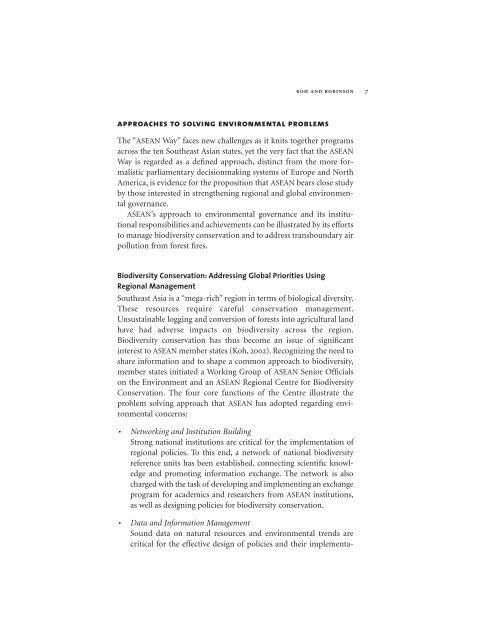Regional Environmental Governance: Examining ... - Yale University
Regional Environmental Governance: Examining ... - Yale University
Regional Environmental Governance: Examining ... - Yale University
Create successful ePaper yourself
Turn your PDF publications into a flip-book with our unique Google optimized e-Paper software.
KOH AND ROBINSON 7<br />
approaches to solving environmental problems<br />
The “ASEAN Way” faces new challenges as it knits together programs<br />
across the ten Southeast Asian states, yet the very fact that the ASEAN<br />
Way is regarded as a defined approach, distinct from the more formalistic<br />
parliamentary decisionmaking systems of Europe and North<br />
America, is evidence for the proposition that ASEAN bears close study<br />
by those interested in strengthening regional and global environmental<br />
governance.<br />
ASEAN’s approach to environmental governance and its institutional<br />
responsibilities and achievements can be illustrated by its efforts<br />
to manage biodiversity conservation and to address transboundary air<br />
pollution from forest fires.<br />
Biodiversity Conservation: Addressing Global Priorities Using<br />
<strong>Regional</strong> Management<br />
Southeast Asia is a “mega-rich” region in terms of biological diversity.<br />
These resources require careful conservation management.<br />
Unsustainable logging and conversion of forests into agricultural land<br />
have had adverse impacts on biodiversity across the region.<br />
Biodiversity conservation has thus become an issue of significant<br />
interest to ASEAN member states (Koh, 2002). Recognizing the need to<br />
share information and to shape a common approach to biodiversity,<br />
member states initiated a Working Group of ASEAN Senior Officials<br />
on the Environment and an ASEAN <strong>Regional</strong> Centre for Biodiversity<br />
Conservation. The four core functions of the Centre illustrate the<br />
problem solving approach that ASEAN has adopted regarding environmental<br />
concerns:<br />
• Networking and Institution Building<br />
Strong national institutions are critical for the implementation of<br />
regional policies. To this end, a network of national biodiversity<br />
reference units has been established, connecting scientific knowledge<br />
and promoting information exchange. The network is also<br />
charged with the task of developing and implementing an exchange<br />
program for academics and researchers from ASEAN institutions,<br />
as well as designing policies for biodiversity conservation.<br />
•<br />
Data and Information Management<br />
Sound data on natural resources and environmental trends are<br />
critical for the effective design of policies and their implementa-
















